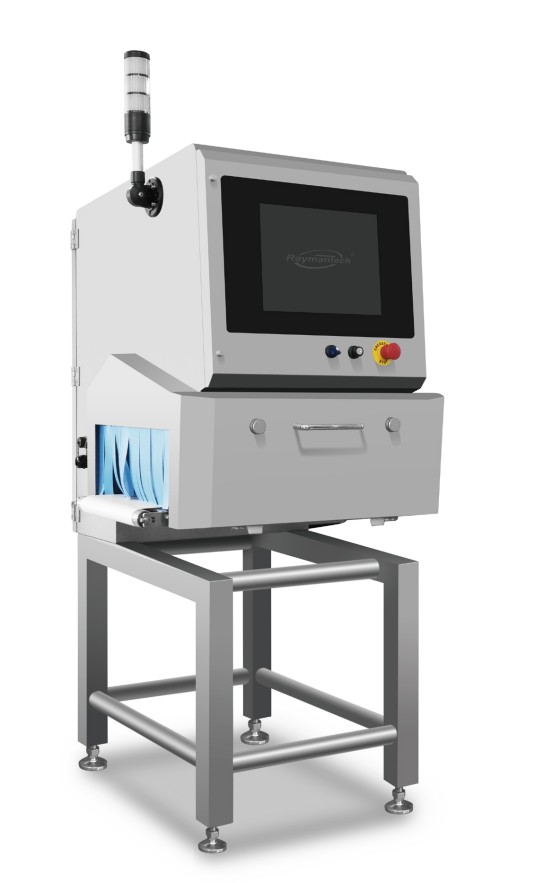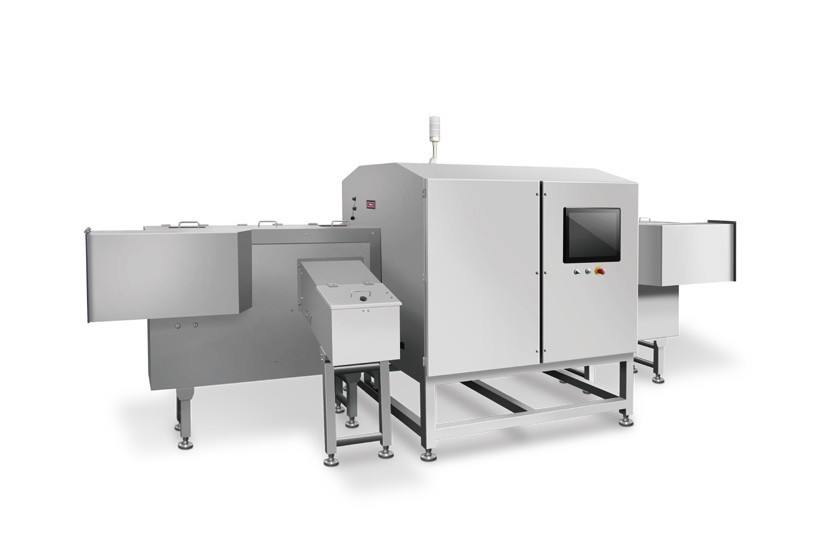How Safe is X-ray Inspection of Food?
Consumers and manufacturers alike worry about contamination in food – broken glass, metal fragments, plastic or stone – entering a product and harming someone or prompting a recall. X-ray inspection systems have become a key solution: conveyors carrying packaged or unpackaged food pass through a shielded X-ray machine that "sees" inside each item. This technology complements traditional metal detectors and manual checks to catch a wider range of hazards. Importantly, extensive research and industry experience show that food X-ray inspection is extremely safe. Nearly everything we eat – from spices to snacks – is X-rayed at some point during production, and regulatory bodies (like the FDA) report "no known adverse effects" from the low-dose X-ray scans used in food plants.
Why X-ray Inspection is Essential for Food Safety
Food manufacturers deploy X-ray inspection systems because of their unmatched ability to detect physical contaminants inside products. Unlike metal detectors, which only find metal, X-rays can reveal dense materials of any kind (metal, glass, stone, ceramic, bone, hard plastic, etc.) wherever they occur inside a package or bulk flow. For example, a dense piece of glass or a chunk of bone that slipped into a can of soup or a bag of nuts can block X-rays and create a telltale image, triggering a reject. X-ray images are analyzed by software (often with AI algorithms) in real time, spotting tiny foreign objects or even product defects that would be invisible otherwise. Modern X-ray food scanners are typically placed inline on the production conveyor, so that every unit – from bulk grain sacks to foil-wrapped chocolates – is scanned at full line speed. This "100% inspection" capability helps catch hazards before they leave the factory, protecting brands and consumers.
Broad contaminant detection. X-ray systems find both metallic and non-metallic foreign objects – metal, glass, plastic, stone, bone and more – and do so without being fooled by the food itself. (For example, contrast rods of stainless steel and glass beads can both be seen by X-ray.) They can inspect products in any shape, in sealed cans or jars, or in flowable bulk, catching defects that manual or visual checks would miss.
Through-packaging scanning. X-rays penetrate packaging, including thick plastics, glass bottles, and even metalized or foil wraps. This means manufacturers can scan finished packages or foil-wrapped candies as easily as loose grains. (By contrast, a metal detector would "go off" on every foil wrapper.) For example, confectionery producers often rely on X-ray machines to inspect foil-wrapped chocolates and hard candies: the metalized wrapper no longer triggers the scanner, and the X-ray can reveal any hidden contaminants inside.
Product integrity checks. Beyond foreign objects, X-ray imaging can verify product quality. Systems can detect missing pieces in a multi-part product, mis-shapes, under-fill or over-fill, broken or misaligned components, and even ensure proper count or weight. For instance, an X-ray image can flag a broken chocolate bar or a missing marshmallow in a cereal bar. These quality-control functions are built into many food X-ray machines and help maintain consistency and yield.
Non-destructive and fast. Unlike laboratory tests or destructive checks, X-ray inspection is completely non-destructive. It provides an internal "picture" of each item without opening packaging or slowing the line. Conveyor-mounted (inline) X-ray machines scan continuously at full speed, enabling high-throughput inspection. By catching contaminants or errors early, the line can divert bad product instantly, reducing waste and recalls.
Industrial X-ray inspection machines (Standard) can inspect metallic, non-metallic packaging and canned products, and the inspection result will not be affected by temperature, humidity, salt content, etc.

Nowadays, manufacturers often use both metal detectors and X-ray scanners in series – raw materials go through a metal detector first, and finished goods then pass an X-ray unit for final safety and quality checks. Together, they leave no contaminants anywhere to hide.
Does X-ray Affect Food Quality or Nutrition?
A common question is whether exposure to X-rays somehow "cooks" or alters food. The short answer is no – modern food X-ray inspection does not measurably change safety, taste, texture, or nutrition. The X-ray dose used for scanning is extremely low (just enough to form an image), and the process is non-thermal and non-invasive. By comparison, a single chest X-ray gives about 100 μSv of exposure; scanning a food item typically involves only 5–10 μSv. Radiation experts note that a food item going through an X-ray machine gets roughly the same dose it would receive sitting outdoors for 2–3 hours. This tiny dose does not heat or chemically alter the food.
No change in taste or texture. X-ray photons simply pass through the food without "cooking" it. Unlike a microwave or infrared heat treatment, there is no appreciable energy deposited in the product. Both industry experience and academic studies confirm that X-ray inspection does not affect flavor or texture. The food emerges from the scan just as it went in – intact and unaltered.
No loss of nutrients. Similarly, nutritional components (vitamins, minerals, proteins, etc.) remain essentially unchanged. The X-ray beam can remove an electron or two at very low probability, but at inspection dose levels this does not degrade nutrients any more than normal background radiation. In short, "the radiation used is non-ionizing" in effect (i.e. it does not create chemical by-products in the food). Nutrition authorities treat the X-ray dose from inspection as negligible.
Not a preservative or sterilization. It's important to distinguish inspection X-rays from food irradiation. Irradiation is a high-dose process (using strong sources like cobalt-60 or powerful accelerators) explicitly intended to kill microbes and extend shelf life. The X-ray units on factory lines use microsecond pulses for imaging only – they do not sterilize or preserve food. Because the dose is so low, X-ray does not affect the nutritional content, taste, or quality of the food. Consumers eating X-rayed food are essentially unaffected; the inspection is non-invasive, leaving the product in its original state.
No induced radioactivity. Another myth is that X-ray machines make food "radioactive." This is incorrect. X-ray inspection uses an external beam produced by an energized tube, not a radioactive source. When the X-ray tube is powered off, the radiation stops immediately. The food itself never becomes a radioactive source. As Kelly Classic (a health physicist) explains, X-ray exposure is not the same as exposing food to radioactive material – it is just radiation passing through. After the X-rays are off, neither the person nor the food becomes radioactive. In effect, scanned food is no different from any other food – it only received a tiny external dose and contains no residual radiation.
In summary, food inspected by X-rays remains safe to eat with no change in flavor, texture or nutrition. Even international bodies that approve food irradiation (which uses much higher doses) note that irradiated food does not become radioactive and has minimal effect on its sensory or nutritional quality.
X-ray Inspection vs. Food Irradiation
It's worth contrasting X-ray inspection with food irradiation, as they are often confused. Both involve radiation, but the purposes and doses are entirely different:
Purpose:
X-ray inspection is a safety and quality check. It uses low-energy X-rays to create an image of each product and detect foreign objects.
Food irradiation, by contrast, is a preservation process. It exposes food to high-energy gamma rays, electron beams, or powerful X-rays (at doses thousands of times higher) to kill pathogens, insects or delay spoilage.
Dose:
Inspection systems use very low doses (on the order of micrograys per scan) – just enough to make an image. Irradiation doses are typically thousands of Gray (kGy), which is lethal to microbes. Because inspection doses are so tiny, they have no practical effect on the food's chemistry.
Radioactivity: Neither process makes food radioactive.
When food is irradiated or X-rayed, the energy simply passes through and the food does not "glow in the dark." Numerous sources emphasize this: for example, UK's leading professional body IFST notes "Food irradiation does not make foods radioactive" – the beam passes through the food and the food never contacts the radiation source. Likewise, X-ray inspection uses an electrically powered tube rather than a nuclear source, and the radiation stops as soon as the tube is off.
Regulation and labeling:
Irradiated foods are subject to special regulation and labeling (in many countries) because of the high doses used, even though they are considered safe by WHO/FAO/Codex. X-ray-inspected foods, on the other hand, are not labeled and remain in the normal processing category. The key is that inspection X-rays are more similar to a medical X-ray or a scanner at the airport – transient, low-dose, and no lasting effect.
In short, X-ray inspection is not a form of food irradiation. It's a brief scan to check for defects. Both processes do not leave any radioactivity in the food, but only food irradiation involves the high-dose beams needed for sterilization.
Safety Standards and System Safeguards
Food plant X-ray machines are designed with multiple safety layers and must meet strict regulatory limits. International and national regulations (FDA in the U.S., IEC standards, UK's IRR99, etc.) cap the allowable radiation leakage to extremely low levels. For instance, U.S. FDA regulations mandate that cabinet X-ray units (like those used for food) emit no more than 0.5 milliroentgen per hour (≈5 μSv/h) at 5 cm distance from the source. Many manufacturers target even tighter limits: a design guideline of ≤1 μSv/h at 5 cm (the US limit combined with UK's stricter 1 μSv/10 cm). These limits are so low that they represent only a tiny fraction of natural background radiation.
To achieve these safety levels, X-ray food inspection machines incorporate numerous safeguards:
Heavy shielding: The X-ray tube is encased in thick metal (typically lead or stainless steel) that absorbs stray radiation. Entry and exit ports (where the conveyor belt passes) are covered by multiple layers of lead curtains or other absorbers. These barriers let products pass while blocking X-rays from escaping.
Safety interlocks: Any panel or door that gives access to the X-ray source has interlocks. If an operator opens a service panel (for cleaning/maintenance), the X-ray beam automatically shuts off. Similarly, if the conveyor jams and needs clearing, the machine is designed to stop the belt and turn off the X-ray immediately. This prevents any accidental exposure if someone reaches inside.
Controlled operation: Most machines include a key-lock switch and emergency-stop button. The key switch prevents unauthorized use, and an emergency-stop lets an operator instantly kill power if needed. A tower light or lamp clearly indicates when X-rays are on, and warning labels mark the beam entry and exit points. Some designs even have a touchscreen "X-ray off" button for quick shutdown.
Routine testing: Every machine is radiation-surveyed after manufacture, before shipment, and again during installation. Vendors keep records of these surveys to prove compliance. By law, any unit exceeding safe levels must be repaired and retested.
Operator safeguards: In normal operation, no worker needs to stand near the open beam. Control panels and operator stations are placed behind the shielded walls of the machine. Occupational limits (e.g. 5 mSv/year for radiation workers) are far above the tiny leakage rates; in practice, studies show operators receive negligible extra dose from these machines.

RaymanTech's X-ray inspection system for food processing. Such machines are fully shielded and interlocked, with conveyor infeed and outfeed (left/right) covered by safety curtains.
Finally, major standards govern these systems. In the U.S., cabinet X-ray units must comply with FDA 21 CFR 1020.40 (Radiological Health). Internationally, IEC 60601-2-14 (for medical X-ray safety) and IEC 61010-2-091 (for industrial X-ray safety) provide collateral guidelines. These rules essentially enforce the design features above (maximum leakage, required interlocks and labels, performance tests, etc.).
In summary, the safety of X-ray inspection equipment is regulated and verified at every step. Machines from reputable manufacturers come fully certified: for example, one food X-ray system maker explicitly notes its unit "is not radioactive, and is certified below 0.5 μSv/hr". The combination of strict limits and built-in protections means that food X-ray scanners can be used 24/7 in factories without undue risk to workers or the environment.
RaymanTech's X-ray Inspection Solutions for Food Products
RaymanTech US offers a variety of X-ray inspection systems tailored to different food applications. These include inline conveyor systems for packaged goods, bulk-flow scanners for grains and snacks, and specialized machines for meat, dairy, or confectionery. RaymanTech's product descriptions highlight how our equipment fits into the examples above:
Packaged foods (bags, boxes, cans) TOP DOWN SERIES. The RaymanTech TOP DOWN SERIES includes the Eco, Standard, and UHD models, offering a versatile range of X-Ray inspection solutions. These systems are designed for efficient, high-sensitivity contamination detection, with a focus on affordability and performance. From the compact Economical X-Ray System to the advanced AI-powered Ultra High Definition X-Ray Food Inspection System, each model is tailored to meet the needs of various production environments.
Bulk products (grains, nuts, beans, cheese, etc.) RXI BHD SERIES . RaymanTech X-Ray Inspection for Bulk Food Products combines X-Ray, visible light, infrared multi-spectrum, and AI intelligent algorithms to enable multi-directional detection of color, shape, density, and material. This advanced system not only effectively detects impurities in raw materials but also identifies both internal and external defects. It precisely removes foreign contaminants such as branches, leaves, paper, stones, glass, plastic, metal, as well as defects like wormholes, mildew, discoloration, and foreign objects with irregular shapes.
Meat and poultry (bone detection) DUAL ENERGY SERIES. RaymanTech Dual-energy X-Ray Inspection System integrates cutting-edge technologies, including holographic dual-energy algorithms, virtual 3D imaging, and non-destructive meat quality analysis. It is especially effective for inspecting uneven products, fish, and meat, delivering outstanding performance in detecting thin and low-density contaminants, such as bones and plastics.
For Glass Bottle / Can MULTI BEAM SERIES. RaymanTech X-Ray Inspection System for Bottled, Jarred & Canned Food is an advanced solution for detecting foreign contaminants such as broken glass, metal shavings, thin plastic, sand, and other impurities that may remain in containers during food production. Utilizing RaymanTech's self-developed "Intelligent Supercomputing" algorithm, the system ensures high-precision inspection across critical areas like bottle bodies, bottoms, screw mouths, tinplate can rings, and container edges. It is designed to handle various container types—including glass bottles, metal cans, plastic cans—and diverse food forms such as powders, granules, solids, semi-fluids, and liquids.
RaymanTech's materials stress that all these machines meet global safety and quality standards. Despite differences in size or configuration, all comply with the strict FDA/IEC safety requirements described earlier.
Together, RaymanTech's product lines illustrate that X-ray inspection is a versatile solution across the food industry – from raw material receiving to final packaged goods. Whether it's detecting a shard of glass in a bulk flour hopper, a bone fragment in poultry, or ensuring every chocolate piece in a box is intact, RaymanTech's X-ray systems carry out these critical food safety tasks without compromising the product.
Conclusion
Modern X-ray inspection of food is both effective and safe. By design, these systems use very low-intensity X-rays and robust safety features. They do not make food radioactive, nor do they change its flavor, texture or nutritional value. International standards (FDA, IEC, IRR99, etc.) and industry best practices ensure that X-ray machines leak imperceptible amounts of radiation, and thousands of companies rely on them daily under strict safety protocols.
For consumers and producers concerned about safety, the data are clear: the benefits far outweigh any risks. X-ray inspection systems help keep dangerous foreign objects out of our food without introducing any hazard of their own. In short, X-ray food inspection is a proven technology that enhances safety and quality, giving both manufacturers and consumers confidence in the foods they produce and eat.


Quick Links
Contact
Tel: 717-490-1513
Add: 1050 Kreider Drive -
Suite 500, Middletown,
PA 17057







